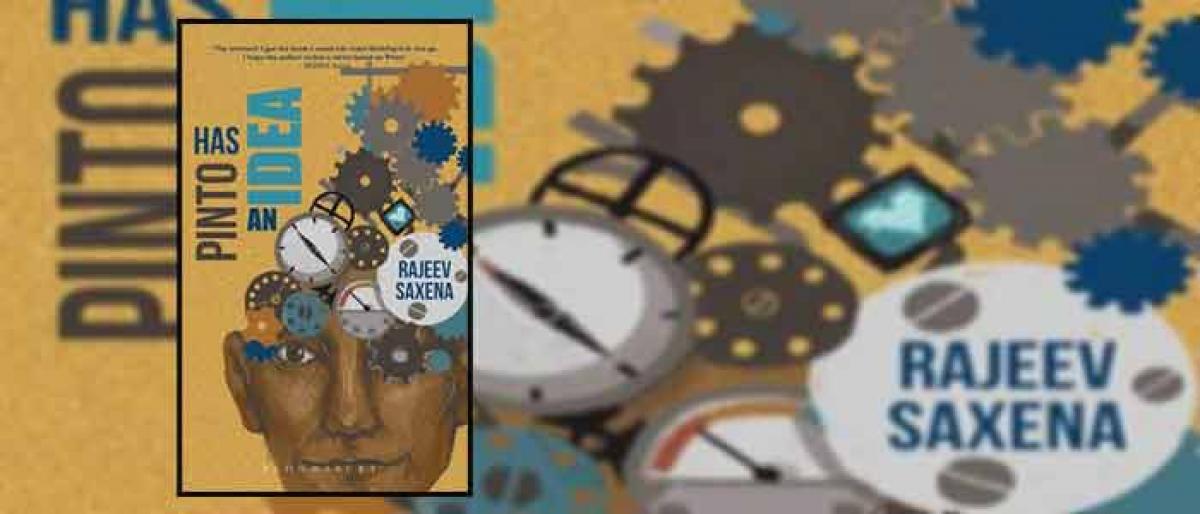Live
- Online Dating and AI: It's a New Age Love Story, says GenZ Daters
- Trees take on myriad unique forms in Ompal Sansanwal's solo exhibition
- Party gives everyone opportunities: Punjab Congress chief at Faridkot campaign
- Nikhil, Dhruva & Nikeetaa secure titles in INAC 2024
- Swati Sharma completed 60 parikramas around Shivling to get scene right
- 189 plaints of MCC violations, 23 cases against hate speeches lodged in Karnataka
- Afridi, Chapman rise; Suryakumar remains No.1 T20 batter in latest ICC T20I rankings
- RBI issues red alert on illegal entities in forex market
- Defence Minister Rajnath Singh slams Congress over 'appeasement' politics
- WB moves SC against Calcutta HC order axing 25,753 school jobs
Just In

Rajeev Saxena’s debut novel ‘Pinto has an Idea’ would win the title of the best way to kill time if there ever was a contest to find the most matter of fact, mundane and mediocre means of doing it. An unimaginative simplistic linear storyline that flows with no particular or conviction the entire novel is just another story among the hordes.
Rajeev Saxena’s debut novel ‘Pinto has an Idea’ would win the title of the best way to kill time if there ever was a contest to find the most matter of fact, mundane and mediocre means of doing it. An unimaginative simplistic linear storyline that flows with no particular or conviction the entire novel is just another story among the hordes. The premise of an innovator overcoming challenges through science and technology while trying to balance work and personal life is strong and interesting hook to draw in the reader but the author dropped the ball big time with a subpar execution.
Pinto aka Rajat is a curious cat who dares to think outside the box. From a humble beginning in a small time village of Uttar Pradesh, he carves a path to better prospects through perseverance and education. His pursuit of answers leads him onto the path of science, through the gates of IIT Kanpur to the hall of MIT. Lavanya is the destined love interest with a typical tragic back-story for the time period her life is set it. The romance is almost non-existent and what little that can pass for romance is also poorly written.
Pinto gains the position of a theoretical physicist and a scientist at MIT but leaves it all to return to India. The earliest cracks in the narrative begin to appear here. The author did a passable job of setting up the protagonist’s childhood and character traits but the abrupt left turn to return to India has no precedence. The author does a shoddy job of establishing conflicts or contexts that may have triggered the uncharacteristic twists in the protagonist’s actions. The events, conversations and actions of Pinto, Lavanya, Imraan and a lot of other characters seem forced and unnatural.
One stand out in the mediocrity was the author’s use of contextual stories, told from the characters’ perspectives. By adding history and context to the issues and possible solutions that Pinto drums up, the author made the outlandish imaginative liberties seem like possible realities. The myriad of problems that Pinto tackles are basic and don’t showcase any moment of brilliance. This is the major let down of the entire novel. The language is kept grounded which aids in reader comprehension but breaks away from the so-called brilliance the protagonist is supposed to embody.
The chapters after Pinto’s return to India are broken down into the level of a children’s story where a problem is presented and then even before the problem is thoroughly established a solution is presented. The solution successfully executed in all most all of the cases. The setups for the problems usually are triggered through Pinto’s interaction with society and particularly Lavanya. The repetitive use of this setup device leads to a boring and monotonic narrative.
The author deserves props for the story idea and genre selection at a time when most books are fad chasing drama, mythological fictions and thrillers. The positives that could be said about the novel and author end there.
I rate the novel a 2 out of 5. The novel’s potential is run down with the basic storyline, stereotypical characters, manufactured relationship conflicts, and generic challenges with flimsy solutions that wouldn’t stand to the least amount of scrutiny.
By: Shirish Kumar

© 2024 Hyderabad Media House Limited/The Hans India. All rights reserved. Powered by hocalwire.com







